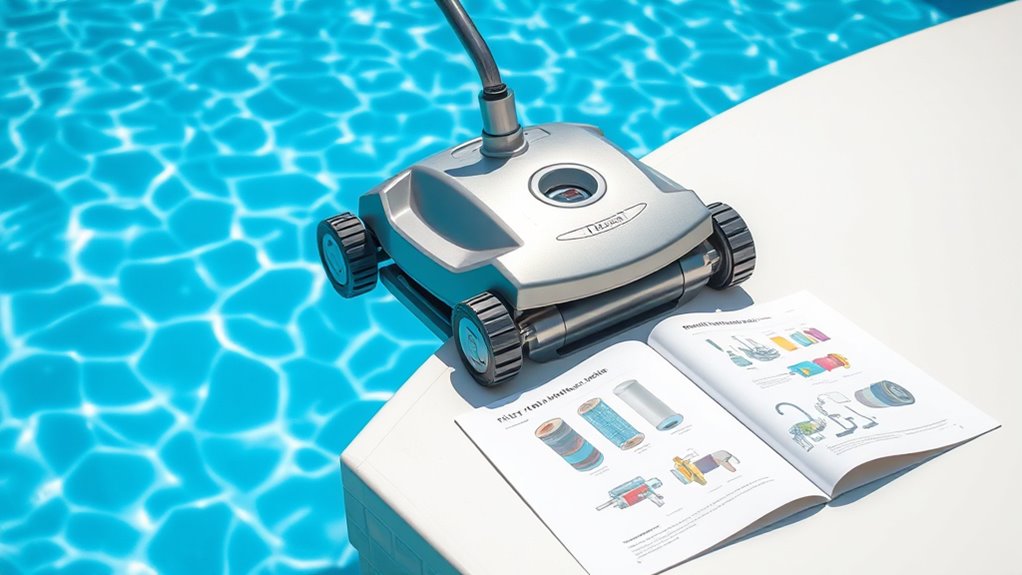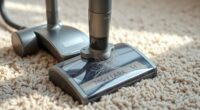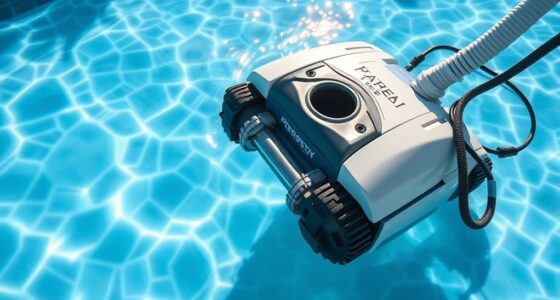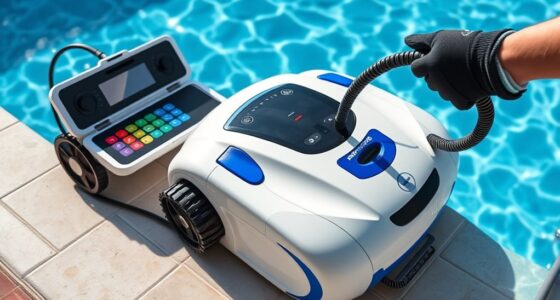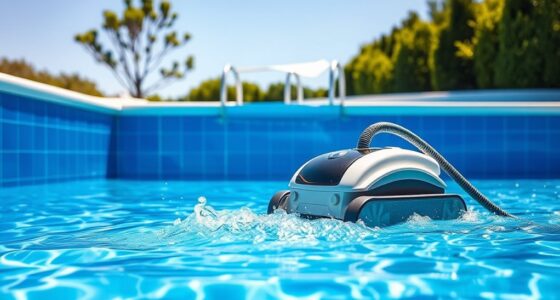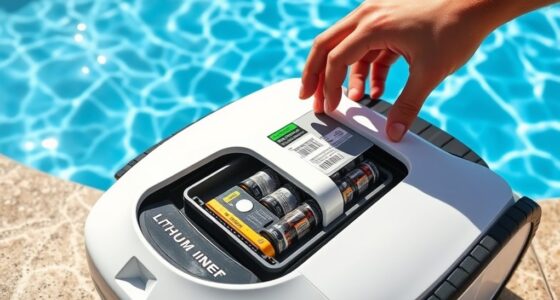To keep your automatic pool cleaner running smoothly, regularly inspect and clean the collection basket, checking for debris and damage. Replace worn brushes, tracks, or drive belts promptly, and make certain wheels and ports are free of obstructions. Lubricate moving parts with appropriate grease and store the equipment properly during off-season. Monitoring batteries and motors, along with following the manufacturer’s schedule, can prevent issues. Keep exploring for detailed tips to extend your cleaner’s lifespan.
Key Takeaways
- Regularly inspect and clean collection baskets, brushes, tracks, and ports to ensure optimal suction and cleaning performance.
- Lubricate moving parts like wheels, bearings, and contact points with appropriate pool equipment grease or silicone lubricant.
- Check and replace worn brushes, drive belts, and damaged components promptly to maintain efficiency.
- Perform routine maintenance on filters, power supplies, and batteries, including cleaning, recharging, or replacement as needed.
- Store equipment properly during the off-season in a dry, ventilated area, and ensure thorough cleaning before storage.
Regularly Inspect and Clean the Collection Basket
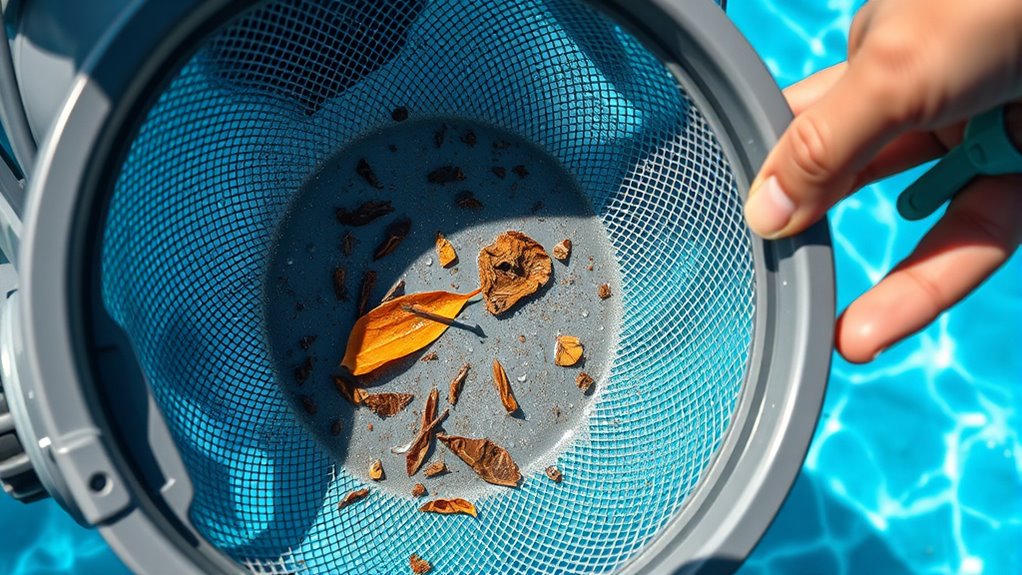
Regularly inspecting and cleaning the collection basket is essential for keeping your automatic pool cleaner functioning effectively. Start by removing the basket and inspecting it for debris or blockages. A clean basket ensures maximum suction and prevents strain on the cleaner’s motor. During this process, check the filter replacement schedule; a clogged filter can hinder performance. While you’re at it, perform a power supply check to confirm the cleaner is receiving consistent power, preventing unexpected stops. Rinse out the basket thoroughly with fresh water and clear any stubborn debris. Regular maintenance like this not only extends your cleaner’s lifespan but also guarantees efficient cleaning. Additionally, paying attention to drivetrain components can inspire creative approaches to routine tasks, making maintenance more engaging. Keeping an eye on performance metrics can help you identify potential issues early and maintain optimal operation. Remember, a well-maintained basket and proper power supply are key to keeping your pool sparkling clean, and understanding the importance of regular maintenance can help you develop a consistent routine.
Check and Replace Worn or Damaged Brushes and Tracks
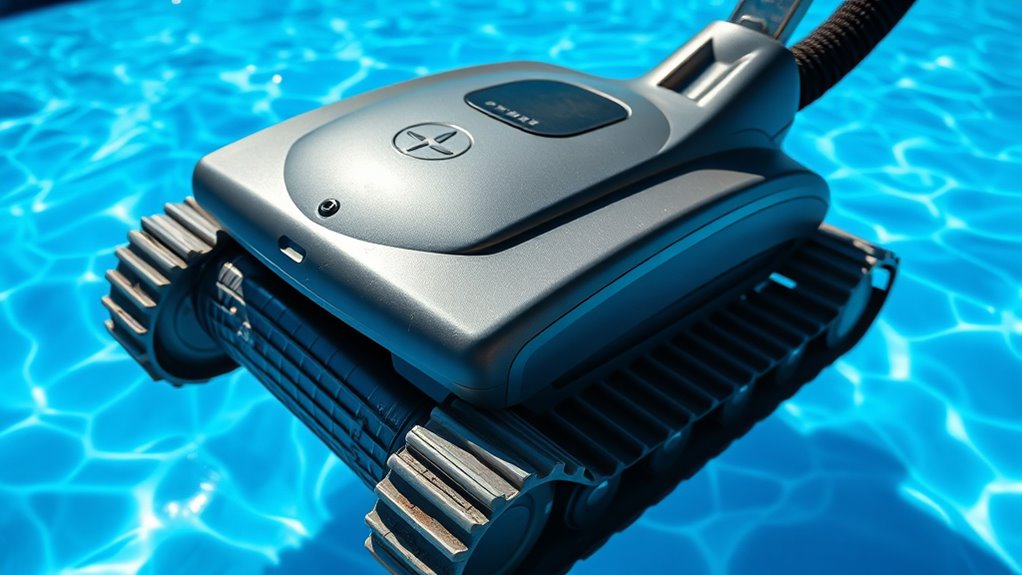
You should regularly check your cleaner’s brushes and tracks for signs of wear or damage. If they look cracked, frayed, or missing pieces, it’s time to replace them to keep your cleaner running smoothly. Follow the manufacturer’s instructions to guarantee proper installation and peak performance. Ensuring that performance kits are compatible with your model can also help maintain optimal cleaning efficiency. Regular maintenance of the toilet cleaner effectiveness used during cleaning can prolong its lifespan and ensure safety during operation. Additionally, understanding spiritual symbols related to transformation can inspire a renewed perspective on upkeep and renewal.
Recognize Wear Signs
Over time, brushes and tracks on your pool cleaner can show signs of wear that diminish its cleaning efficiency. Look for wear signs such as frayed bristles, cracks, or missing pieces. These can cause poor debris pickup and may lead to motor issues if debris jams the system. Regularly inspect the parts below:
| Wear Signs | Potential Cause | Action Needed |
|---|---|---|
| Worn or frayed brushes | Age, frequent use | Replace immediately |
| Damaged or cracked tracks | Impact, debris | Check and replace |
| Reduced cleaning performance | Wear signs, motor issues | Clean, replace parts if needed |
Additionally, utilizing preventive maintenance and data analysis can help monitor the condition of your pool cleaner and predict when maintenance is required, preventing unexpected failures. Implementing regular inspection routines can further enhance the longevity of your equipment. Proper storage and cleaning after each use also contribute to extending the lifespan of these parts, especially in environments with harsh water conditions. Regularly examining wear indicators can help identify early signs of deterioration, ensuring timely replacements and optimal performance.
Proper Replacement Techniques
To guarantee your pool cleaner continues to operate effectively, it’s vital to properly check and replace worn or damaged brushes and tracks. Start by inspecting the brushes for signs of wear, such as fraying or missing bristles, and ensure the tracks move smoothly without sticking. Before replacing parts, verify that your pool’s chemical balance and water pH regulation are properly maintained, as imbalanced water can accelerate wear. When installing new brushes or tracks, follow the manufacturer’s instructions carefully, making sure they’re securely attached. Regularly cleaning the replacement parts prevents debris buildup that can hinder performance. Proper maintenance of pool water chemistry can significantly extend the lifespan of your cleaner components. Additionally, understanding how pool cleaner components function together can help you identify issues early and perform effective maintenance. Being familiar with common cleaner troubleshooting techniques can further aid in maintaining optimal operation. Developing a routine inspection schedule can help catch potential problems before they cause serious damage. By maintaining proper water chemistry and replacing worn components promptly, you’ll keep your pool cleaner functioning efficiently and extend its lifespan. Regularly inspecting brushes and tracks for damage ensures early detection of issues before they lead to costly repairs.
Clean and Maintain the Tracks and Wheels
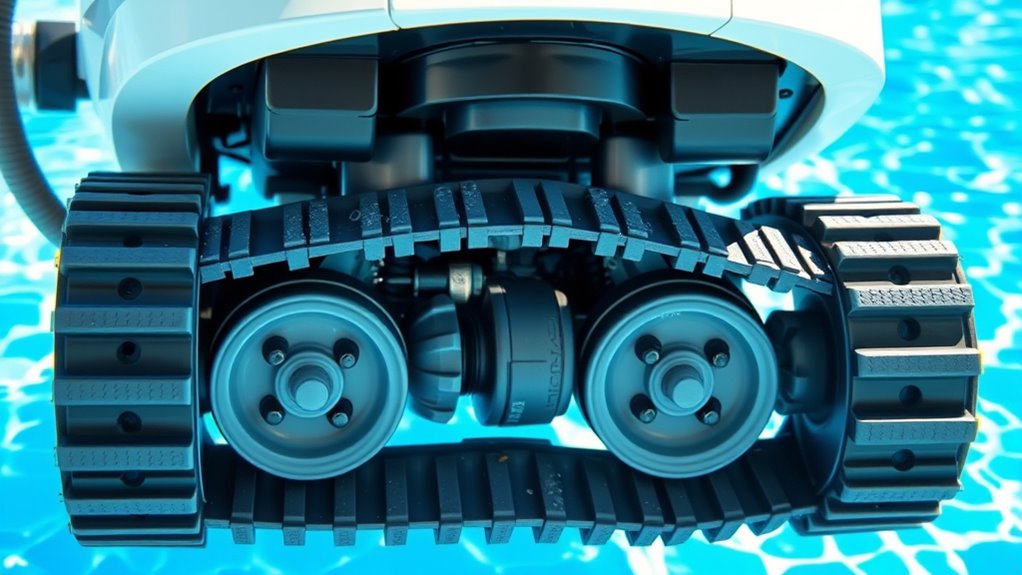
Start by inspecting the tracks and wheels for any debris or buildup that could hinder their movement. If you find any, clear it away carefully to keep your cleaner running smoothly. Don’t forget to lubricate the moving parts to reduce friction and prevent wear over time. Regular maintenance of these components ensures long-lasting performance and keeps your pool cleaner functioning efficiently. Additionally, check for air leaks that could affect the pressure and movement of the cleaner, addressing any issues promptly. Ensuring proper cultural heritage awareness can help you maintain the cleaner with respect to environmentally friendly practices. Proper maintenance of the contrast ratio in your equipment can also help optimize performance and image quality over time. Being aware of potential environmental impacts can guide you toward more sustainable maintenance practices.
Inspect for Debris
Regularly inspecting the tracks and wheels for debris is vital to keep your pool cleaner functioning smoothly. Clear out any leaves, dirt, or hair buildup that could hinder movement. While doing so, check the filter replacement schedule to guarantee optimal suction and cleaning performance. Additionally, inspect the power source checks to confirm the cleaner is receiving proper electrical signals. Loose or tangled debris can cause the wheels to seize or slip, reducing efficiency. Clean the tracks and wheels with a damp cloth or soft brush, removing any stubborn dirt. Maintaining a debris-free track system prevents unnecessary strain on the motor and prolongs the lifespan of your cleaner. Regular inspections are simple yet essential for consistent, trouble-free operation.
Lubricate Moving Parts
Applying lubricant to the moving parts of your pool cleaner guarantees smooth operation and lessens wear on the tracks and wheels. To keep them functioning properly, lubricate bearings regularly, ensuring they move freely. Use a silicone-based lubricant or apply grease specifically designed for pool equipment. Start by removing any debris or dirt from the tracks and wheels, then carefully apply a small amount of lubricant to the bearings and contact points. Be cautious not to over-lubricate, as excess grease can attract dirt and debris. Proper lubrication reduces friction, prevents squeaking, and extends the lifespan of your cleaner’s moving parts. Regular maintenance like this keeps your pool cleaner operating efficiently, saving you time and effort in the long run.
Inspect and Clear the Skimmer and Intake Ports
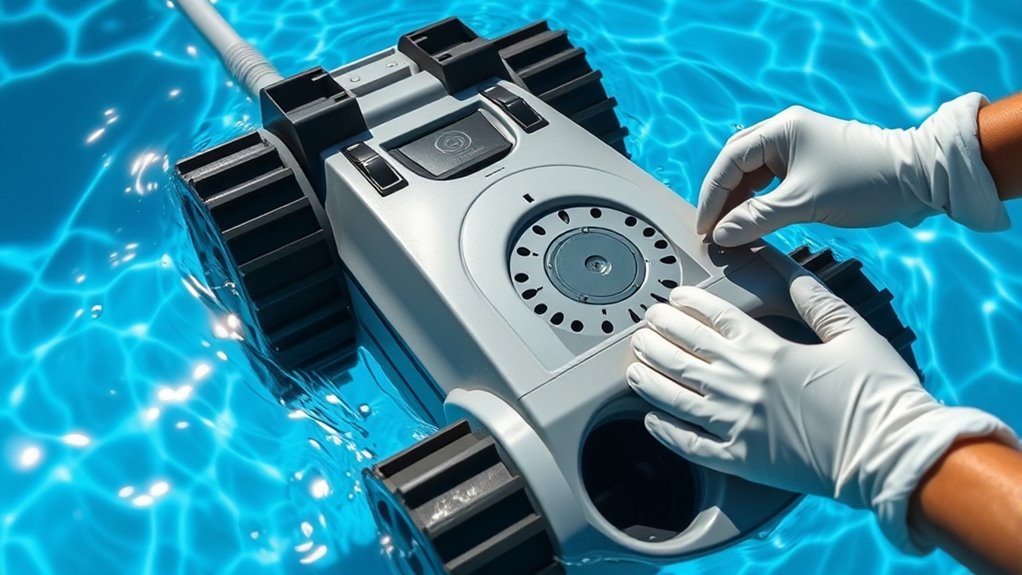
To guarantee your automatic pool cleaner operates efficiently, you need to inspect and clear the skimmer and intake ports regularly. Dirt, debris, or algae can clog these openings, reducing suction and cleaning performance. Carefully remove debris from the ports using a brush or your fingers. Check for any obstructions that could block water flow or cause strain on your cleaner’s pump. While doing this, it’s a good time to perform filter replacement and ensure your power source maintenance is up to date. Visualize:
- Debris and leaves blocking intake ports
- Dust buildup around skimmer openings
- Worn or cracked seals hindering suction
Clearing these ensures maximum operation, prolongs equipment life, and keeps your pool spotless. Regular checks prevent unnecessary strain and maintain peak cleaning power.
Test and Replace the Drive Belt if Necessary
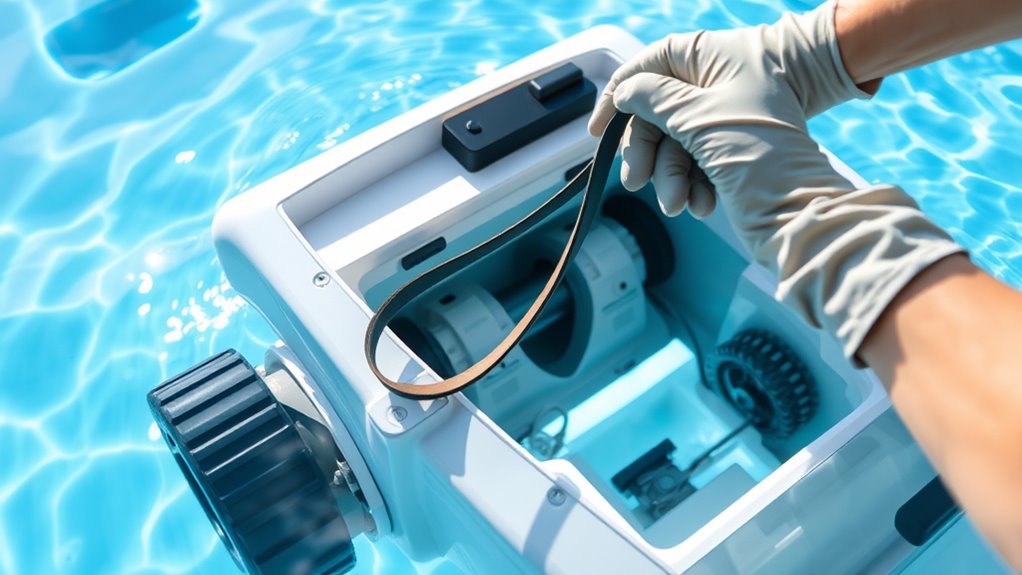
If your automatic pool cleaner isn’t moving smoothly or seems less effective, it’s time to test the drive belt. Begin with a drive belt inspection by removing the cleaner’s cover to check for signs of wear, cracks, or stretching. If the belt appears damaged or slack, it needs replacing. Belt replacement techniques are straightforward: loosen the tensioner, carefully slide out the old belt, and install a new one, ensuring it fits snugly around all pulleys. Make sure the belt is properly aligned and tensioned before reassembling the cleaner. A worn or broken drive belt hampers movement, reducing cleaning efficiency. Regular inspection and timely replacement keep your pool cleaner operating at peak performance, saving you time and preventing more extensive repairs down the line.
Store Your Cleaner Properly During Off-Season
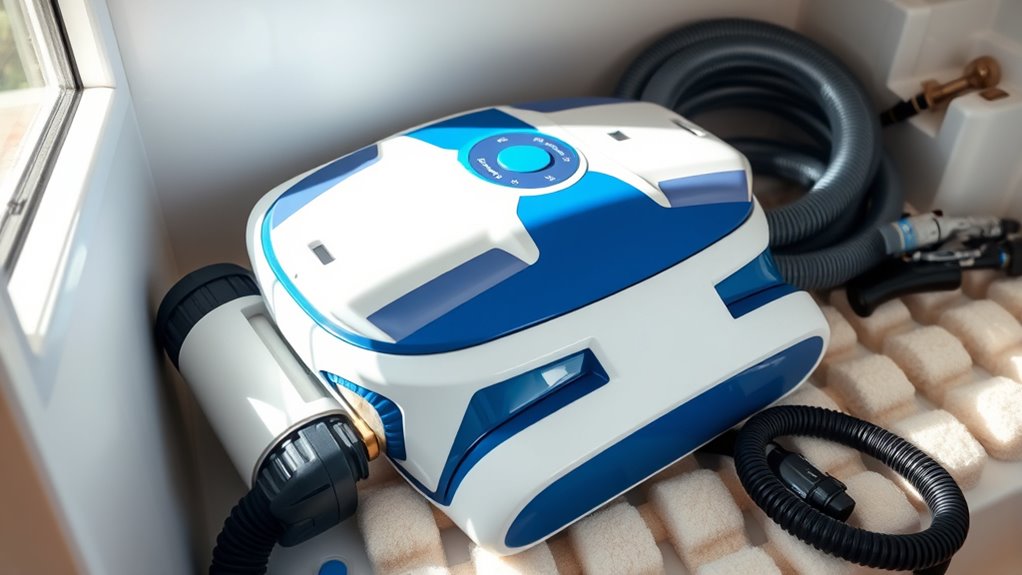
Properly storing your automatic pool cleaner during the off-season helps prevent damage and guarantees it’s ready to use when swimming weather returns. Good off season care involves proper storage tips to keep your cleaner in top shape. Store it in a cool, dry place away from direct sunlight to prevent material degradation. Make sure the unit is clean and free of debris before storing it. You should also disconnect batteries and ensure motor parts are dry to avoid corrosion. To paint a clear picture:
Proper off-season storage keeps your pool cleaner in top condition for next season.
- Hang the cleaner or place it on a shelf in a well-ventilated area
- Keep accessories and cords organized and protected
- Cover the cleaner with a breathable cover to shield it from dust
Following these storage tips ensures your cleaner stays in excellent condition year-round.
Perform Routine Battery and Motor Checks (For Battery-Powered Models)
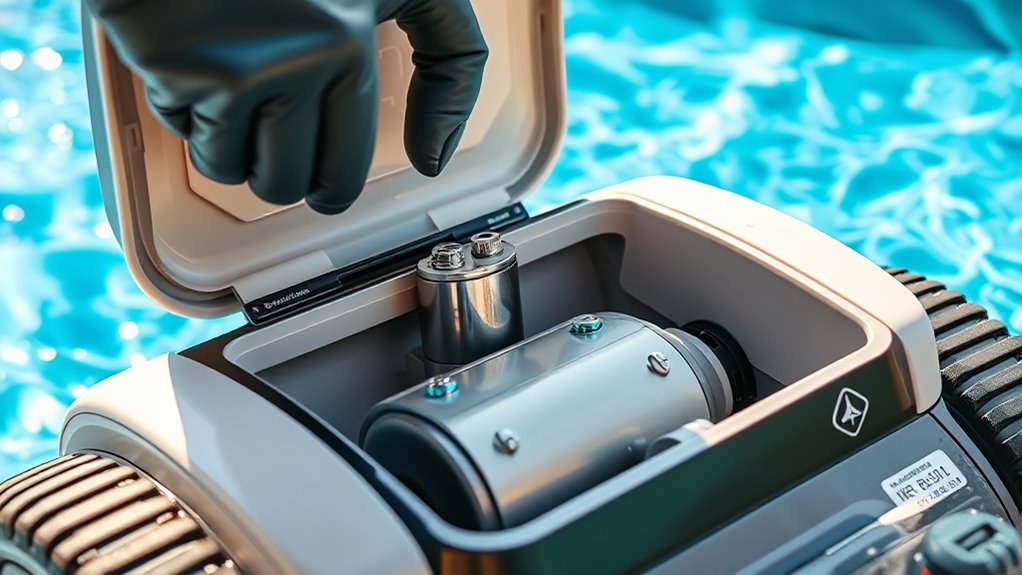
Routine battery and motor checks are essential to keep your battery-powered pool cleaner functioning efficiently. Regularly inspecting the battery performance ensures it holds a proper charge and maintains power output. If your cleaner isn’t running as long or quickly as before, the battery may need recharging or replacing. Additionally, check the motor for signs of wear or unusual noise, which could indicate reduced motor efficiency. Keep the motor clean and free of debris to prevent overheating and ensure smooth operation. Use the manufacturer’s recommended tools and procedures for these checks, and avoid neglecting this routine maintenance. Consistently monitoring battery and motor health helps prevent unexpected failures, prolongs your cleaner’s lifespan, and guarantees ideal cleaning performance each time you use it.
Follow Manufacturer’s Maintenance Schedule and Troubleshooting Tips
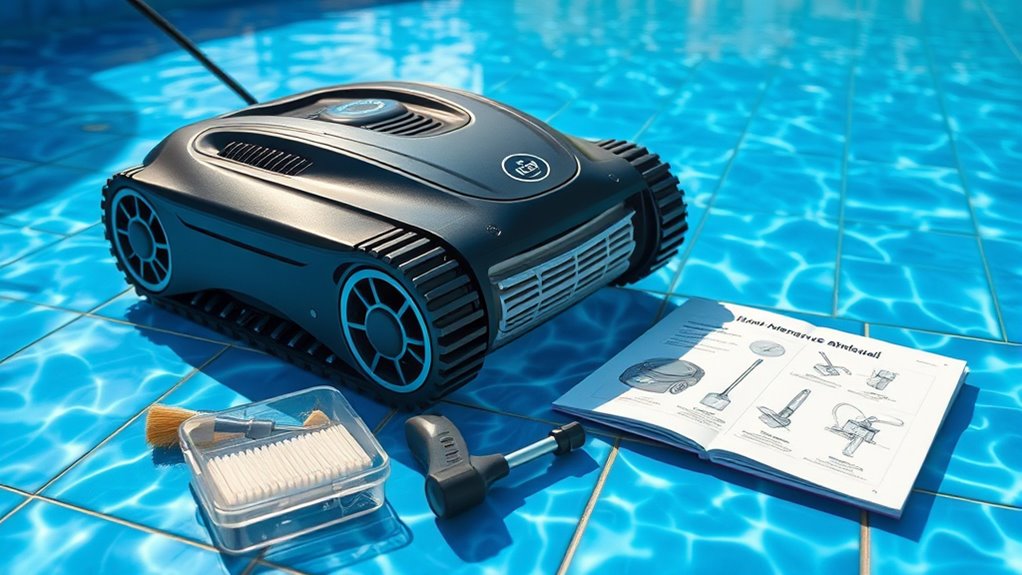
Following the manufacturer’s maintenance schedule and troubleshooting tips helps keep your pool cleaner in top shape. Regularly checking and adjusting pool water chemistry ensures maximum cleaning performance and prevents damage. Adhering to pool safety regulations, like ensuring proper wiring and grounding, keeps everyone safe. When troubleshooting, look for common issues such as clogs, brush wear, or motor problems. These can often be resolved with straightforward steps, saving you time and money. To stay on track:
- Clean filters and brushes as recommended
- Inspect for debris or blockages regularly
- Follow calibration and calibration guidelines
Frequently Asked Questions
How Often Should I Replace the Entire Pool Cleaner?
You should consider replacing your automatic pool cleaner based on its replacement schedule and lifespan considerations. Typically, most cleaners last about 3 to 5 years with proper maintenance. Keep an eye on its performance—if it’s no longer cleaning effectively or has frequent breakdowns, it might be time for a replacement. Regularly inspecting parts and following manufacturer recommendations can help you determine the right time to upgrade.
Can I Use Household Chemicals to Clean the Cleaner’S Parts?
Think of your pool cleaner as a brave explorer steering through your watery kingdom. You might wonder if household solutions are safe for cleaning its parts. While chemical cleaning with household chemicals seems tempting, it can damage delicate components or leave residues that harm your pool. Instead, use manufacturer-recommended cleaning solutions, ensuring your cleaner’s safety and longevity. Trust the right products to keep your pool explorer in top shape.
What Are Signs That My Cleaner’s Motor Is Failing?
If your pool cleaner’s motor is failing, you’ll notice signs like decreased cleaning performance or the cleaner not moving at all. Strange noises such as grinding or buzzing could also indicate motor failure. You might see the motor overheating or smell burning. These signs mean you should examine the motor promptly and consider replacing or repairing it to avoid further damage and ensure your pool stays clean.
Is It Safe to Leave the Cleaner in the Pool Year-Round?
Leaving your cleaner in the pool year-round isn’t always safe or recommended. Consider pool cover considerations and seasonal storage tips to prevent damage from weather and debris. When not in use, it’s best to remove and store your cleaner in a dry, cool place. This prolongs its lifespan and ensures it functions properly when needed. Always follow manufacturer instructions for seasonal storage to keep your cleaner in top shape.
How Do I Troubleshoot if the Cleaner Is Not Moving Properly?
Imagine your cleaner as a diligent worker; if it’s not moving properly, it’s like a tired worker missing steps. First, check for sensor issues—dust or debris might be confusing it. Then, inspect for blockage removal around the brushes or wheels. Clearing out obstructions and ensuring sensors are clean helps restore its rhythm, allowing your cleaner to glide smoothly across the pool, just like a well-trained dancer on stage.
Conclusion
By staying on top of these maintenance tips, you’ll keep your pool cleaner running smoothly—no need to call in a wizard from Camelot! Regular inspections and timely replacements will extend its life and ensure your pool stays pristine. Remember, even the most trusty robot needs some TLC. So, channel your inner medieval knight and defend your oasis, making pool upkeep as effortless as a swing on a sunny day.
